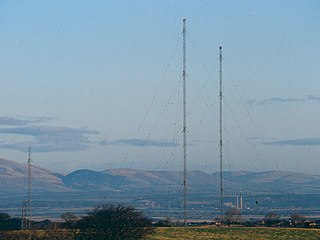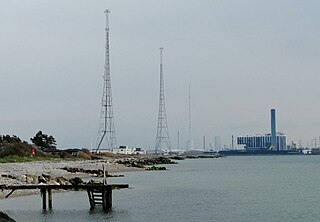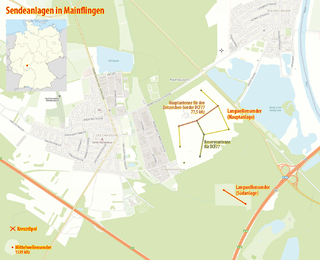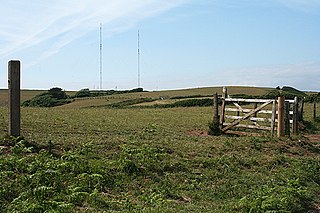
Medium wave (MW) is the part of the medium frequency (MF) radio band used mainly for AM radio broadcasting. The spectrum provides about 120 channels with more limited sound quality than FM stations on the FM broadcast band. During the daytime, reception is usually limited to more local stations, though this is dependent on the signal conditions and quality of radio receiver used. Improved signal propagation at night allows the reception of much longer distance signals. This can cause increased interference because on most channels multiple transmitters operate simultaneously worldwide. In addition, amplitude modulation (AM) is often more prone to interference by various electronic devices, especially power supplies and computers. Strong transmitters cover larger areas than on the FM broadcast band but require more energy and longer antennas. Digital modes are possible but have not reached momentum yet.
Low frequency (LF) is the ITU designation for radio frequencies (RF) in the range of 30–300 kHz. Since its wavelengths range from 10–1 km, respectively, it is also known as the kilometre band or kilometre wave.

In radio, longwave, long wave or long-wave, and commonly abbreviated LW, refers to parts of the radio spectrum with wavelengths longer than what was originally called the medium-wave broadcasting band. The term is historic, dating from the early 20th century, when the radio spectrum was considered to consist of longwave (LW), medium-wave (MW), and short-wave (SW) radio bands. Most modern radio systems and devices use wavelengths which would then have been considered 'ultra-short'.

The Berliner Funkturm or Funkturm Berlin is a former broadcasting tower in Berlin. Constructed between 1924 and 1926 to designs by the architect Heinrich Straumer, it was inaugurated on 3 September 1926, on the occasion of the opening of the third Große Deutsche Funkausstellung in the grounds of the Messe Berlin trade fair in the borough of Charlottenburg-Wilmersdorf. Nicknamed der lange Lulatsch, the tower is one of the best-known points of interest in the city of Berlin and, while no longer used for broadcasting purposes, it remains a protected monument.

Sender Zehlendorf or Zehlendorf (radio) transmission facility was a radio transmission facility which was in service since 1936, when a short wave transmitter was built on the occasion of the Berlin 1936 Summer Olympics in Zehlendorf as part of the establishment of permanent radio services. This Zehlendorf site, which until the end of World War II was referred to as the Rehmate Radio Transmission Centre, had 26 different antennas at the time.

The Roumoules transmitter is the main broadcasting facility for longwave and mediumwave broadcasting of Radio Monte Carlo near Roumoules, France and is owned by Monaco Media Diffusion. The 1000 and 2000kW transmitters installed are among the most powerful in the world and can be received well at nighttime throughout Europe.

The Droitwich transmitting station is a large broadcasting facility for long-wave and medium-wave transmissions, established in 1934 in the civil parish of Dodderhill, just outside the village of Wychbold, near Droitwich in Worcestershire, England. The site is the location of the British Broadcasting Corporation's most powerful long-wave transmitter, which together with the two Scottish long-wave transmitters at Burghead and Westerglen forms a network broadcasting on the same frequency. The masts can be seen to the east from the M5 motorway, between Droitwich and Bromsgrove, as well as to the west from the Herefordshire/Worcestershire border. At night, the two sets of aircraft warning lights are visible from a long distance. Due to the bright red lights illuminated at night, some locals have renamed the site "the devil horns of Wychbold". The station is owned and operated by Arqiva.

The Burghead transmitting station is a broadcasting facility near Burghead in Scotland for long wave and medium wave radio transmission that started service on 12 October 1936. The site is owned by Arqiva and houses a long wave radio transmitter on 198 kHz broadcasting BBC Radio 4 and two medium wave radio transmitters, broadcasting BBC Radio 5 Live on 693 kHz and BBC Radio Scotland on 810 kHz. The long wave transmitter is part of a network transmitting on the same frequency, the other transmitters being Droitwich and Westerglen.

The Westerglen transmitting station is a facility for longwave and mediumwave broadcasting established in 1932 at Westerglen Farm, 2 miles (3 km) south west of Falkirk, Stirlingshire, Scotland.

Kalundborg Radio is a major transmission facility for long- and mediumwave at the harbour of Kalundborg in Denmark.

The Mainflingen mediumwave transmitter is a mediumwave transmission facility south of the A3 motorway near Mainflingen, Hesse, Germany. Mainflingen was the first mediumwave transmitter for the radio station Deutschlandfunk. It went into service in 1962 with a transmission power of 50 kW, on a frequency of 1538 kHz, at the upper end of the mediumwave band. This frequency has a bad groundwave propagation and therefore a low range at daytime, but an excellent skywave propagation with a long range at night.

Rampisham Down is a chalk hill in the Dorset Downs, eight miles north west of Dorchester in west Dorset, England. The highest part of the hill is 221 metres (720 feet). To the north east of the hill is the Frome valley and the village of Rampisham, to the south west is the Hooke valley and the village of Hooke. The A356 road between Dorchester and Crewkerne cuts across the down.

Borough Hill is a hill to the east of the town of Daventry in the English county of Northamptonshire. It is over 200 metres (660 ft) above sea level and dominates the surrounding area.
The Orfordness transmitting station was a major radio broadcasting facility at Orford Ness on the Suffolk coast in the United Kingdom able to broadcast to much of Europe. It closed in May 2012 after more than 30 years of service. In 2017 Radio Caroline started broadcasting from the site, though not with the same intended coverage of an audience in Europe as the original station.

The BBC National Programme was a radio service which was on the air from 9 March 1930 – replacing the earlier BBC's experimental station 5XX – until 1 September 1939 when it was subsumed into the Home Service, two days before the outbreak of World War II.
Deutschlandsender Zeesen was a facility for longwave broadcasting near Zeesen, a district of Königs Wusterhausen in Germany. Built by the German Reichspost in 1927, it served the nationwide Deutschlandsender radio transmissions by the Deutsche Welle broadcaster.

The Wiederau transmitter is the oldest broadcasting facility in Saxony. It is located near Wiederau, a village which is part of the municipality of Pegau, and is used for medium-wave, FM and Television broadcasting.

The Lisnagarvey transmitting station is a facility for mediumwave broadcasting located in the townland of Magherageery, on the southern edge of Lisburn, Northern Ireland. It is close to Sprucefield shopping centre and about one mile from the middle of Lisburn.

The Start Point transmitting station is a broadcasting facility at Start Point, Devon, owned by Arqiva. The site is just north-west of the Start Point lighthouse.
2BD was a local radio station opened on 10 October 1923 in Aberdeen, Scotland, by the British Broadcasting Company. Operating from a studio at the rear of a shop belonging to Aberdeen Electrical Engineering at 17 Belmont Street and a transmitter located on the premises of the Aberdeen Steam Laundry Company, the station broadcast on a frequency of 606 kHz medium wave.
















